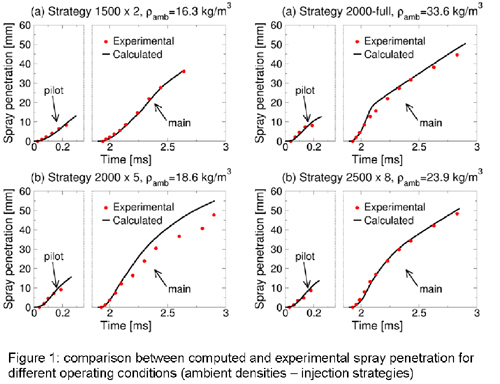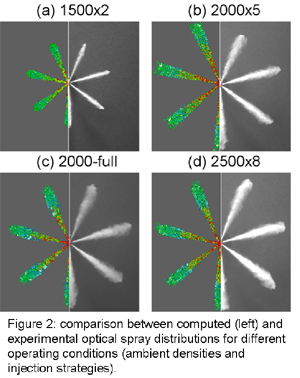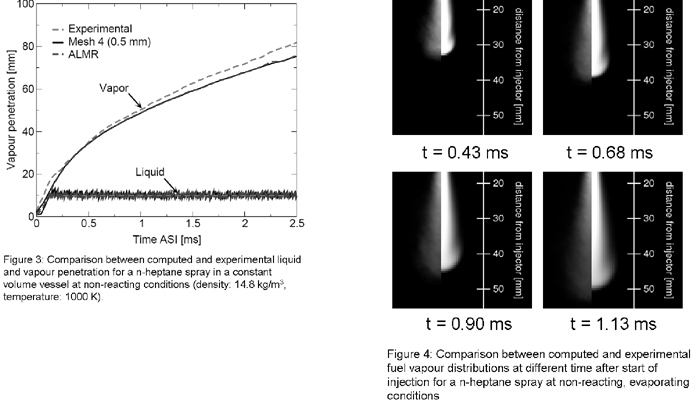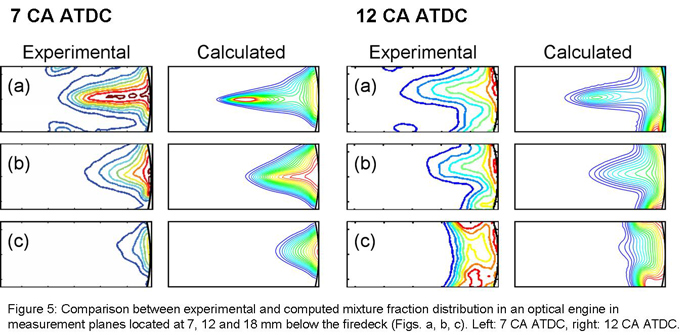Lagrangian spray models
Nowadays, computational fluid dynamics is applied to model the fuel-air mixture formation in direct injection engines, since this process plays a great influence on combustion efficiency an
in-cylinder emissions. To this end, the well known Eulerian-Lagrangian approach is widely used despite simulation results show a strong dependency on the used sub-models and on the grid-size.
Within this context the activity of the research group is focused on the following aspects:
» Fuel atomization at high pressure conditions;
» Relevant length scales close to the injector nozzle;
» Turbulence-spray interaction;
» Interpolation of the gas phase quantities at parcel positions;
» Definition of an optimum grid size.
And a proposed methodology to simulate high-pressure sprays was recently developed in collaboration with Prof. Gianmarco Bianchi and Dr. Federico Brusiani from DIEM (UniversitÓ degli Studi di Bologna).
 Fuel atomization is modeled by a hybrid atomization model accounting for both the turbulence and Kelvin Helmoltz instabilities taking place on the liquid jet. The diameter of the secondary droplets
stripped from the liquid core is derived from DNS calculation of liquid jet breakup at different ambient conditions. The secondary breakup process was modeled accounting for the Kelvin-Helmoltz
theory. The possibility to dynamically refine the grid during the penetration of the liquid and vapor spray was also included in the proposed methodology, in this way it is possible to reduce the
computational time since the grid is refined only where the fuel-air mixing process takes place.
Fuel atomization is modeled by a hybrid atomization model accounting for both the turbulence and Kelvin Helmoltz instabilities taking place on the liquid jet. The diameter of the secondary droplets
stripped from the liquid core is derived from DNS calculation of liquid jet breakup at different ambient conditions. The secondary breakup process was modeled accounting for the Kelvin-Helmoltz
theory. The possibility to dynamically refine the grid during the penetration of the liquid and vapor spray was also included in the proposed methodology, in this way it is possible to reduce the
computational time since the grid is refined only where the fuel-air mixing process takes place.
 The proposed approach was validated both at evaporating and non-evaporating conditions with different injection strategies and different fuels. The Figure 1 illustrates the validation carried out
at non-evaporating conditions in collaboration with Dr. Montanaro and Dr. Allocca from CNR-Istituto Motori. Four different injection strategies (pilot+main) and ambient densities were considered.
The model is able to correctly reproduce the experimental spray penetration both during the pilot and the main injection events. The Figure 2 illustrates a comparison between the computed spray
shapes and experimental optical images for the considered injection strategies.
The proposed approach was validated both at evaporating and non-evaporating conditions with different injection strategies and different fuels. The Figure 1 illustrates the validation carried out
at non-evaporating conditions in collaboration with Dr. Montanaro and Dr. Allocca from CNR-Istituto Motori. Four different injection strategies (pilot+main) and ambient densities were considered.
The model is able to correctly reproduce the experimental spray penetration both during the pilot and the main injection events. The Figure 2 illustrates a comparison between the computed spray
shapes and experimental optical images for the considered injection strategies.
Experimental data taken from the SANDIA Engine Combustion Network Database were used for the validation at evaporating conditions. The Figure 3 illustrates that the model predicts rather well the spray penetration. A comparison between the computed and experimental spray vapour regions is shown in Figure 4 for different times after the start of injection.

Finally, the fuel-air mixture formation was simulated in an optical engine, and Figure 5 shows a comparison between the computed and experimental distributions at different imaging planes located 7 mm, 12 mm and 18 mm below the firedeck.

Download movies with examples of spray simulations with adaptive local mesh refinement:
» sandiaVesselALMR.gif
» opticalEngine.gif
Publications:
1 - D'Errico G., Ettorre D., Lucchini T., Simplified and Detailed Chemistry Modeling of Constant-Volume Diesel Combustion Experiments, SAE Paper 2008-01-0954, SAE International Journal of
Fuel and Lubricants, Vol. 1, pp. 452-465, 2009.
2 - Lucchini T., D'Errico G., Ettorre D., Ferrari G., Numerical investigation of non-reacting and reacting Diesel sprays in constant-volume vessels, SAE Technical Paper 2009-01-1971, 2009.
3 - Lucchini T., Ettorre D., D'Errico G., Brusiani F., Bianchi G. M., Montanaro A., Allocca L., Experimental and Numerical Investigation of High-Pressure Diesel Sprays with Multiple
Injections at Engine Conditions, to be presented at the SAE 2010 Word Conference, Detroit.








